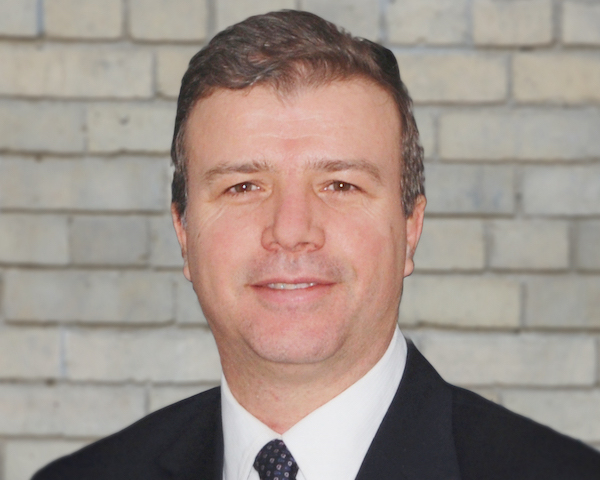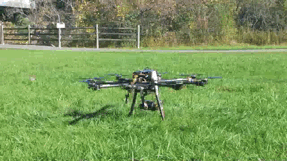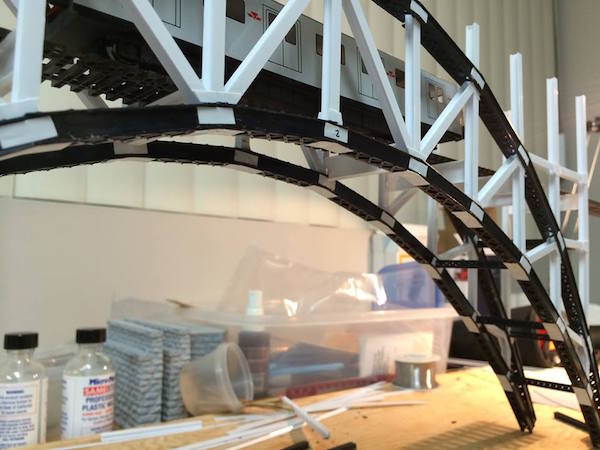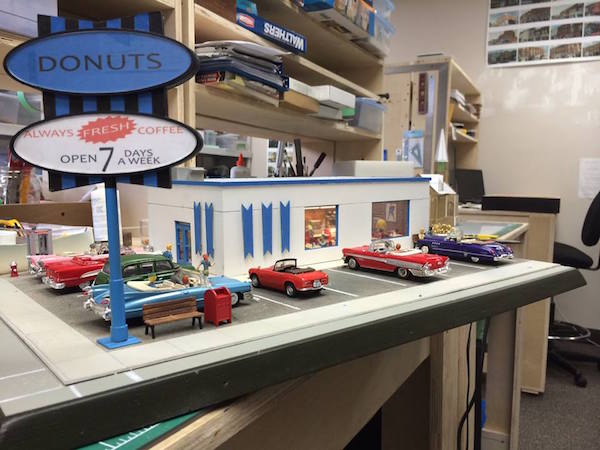University of Toronto Engineering professor Craig Simmons (MIE, IBBME) has received the 2015 CP Has Heart Cardiovascular Award from the Heart and Stroke Foundation and Canadian Pacific in the amount of $288,867 to support his research in finding a treatment for diseased heart valves. He is one of 10 researchers to be selected among 454 grant applications from across Canada and awarded a total of $3 million over three years for their work in multi-generational heart health.
As the Canada Research Chair in Mechanobiology, part of Simmons’ research looks at the mechanics of heart valves and the underlying causes associated with their failure. In particular, he will be using the funding from this award to investigate if a molecule known as CNP can help slow the progression of calcific aortic valve disease with a long-term goal to improve patients’ quality of life.
Approximately 1.3 million Canadians live with a form of heart disease.
“Our work has shown that the CNP molecule is important to maintain healthy heart valves,” said Simmons. “This award will support of our collaborative efforts with researchers in engineering and medicine to test CNP as a treatment for valve disease, which affects over a million Canadians but is not treatable medically.”
Earlier this year, Simmons was appointed scientific director of the Translational Biology & Engineering Program (TBEP), a new multidisciplinary research initiative within the recently established Ted Rogers Centre for Heart Research that will bring together investigators from Sick Kids Hospital, University Health Network and University of Toronto to advance discoveries and accelerate new treatments for cardiovascular disease. He and seven other U of T Engineering and Medicine researchers will be occupying an entire floor of the MaRS Phase 2 building in Toronto’s Discovery District later this year.
“This award advances our collaborative efforts to address a critical challenge in human health,” said Christopher Yip, professor and director of the Institute of Biomaterials & Biomedical Engineering (IBBME) at the University of Toronto. “Congratulations to Craig on this recognition and my sincerest thanks for his pioneering leadership in furthering our research cause for better treatments of cardiovascular disease.”
“Professor Craig Simmons has a brought an innovative and important perspective to the research of heart valve disease, and this well-deserved award brilliantly demonstrates not only his leadership in this field, but also our department’s dedication to revolutionizing health care and biomedical engineering,” said Jean Zu, chair of the Department of Mechanical & Industrial Engineering at U of T.
With files from the Heart and Stroke Foundation and U of T Engineering Strategic Communications

U of T Engineering professor Ridha Ben-Mrad (MIE) has been appointed Mitacs’ new associate academic director, beginning January 2016.
Mitacs is a national, not-for-profit organization that offers research and training programs for Canadian undergraduates, graduate students and postdoctoral fellows. Partnering with 60 universities, thousands of companies and both federal and provincial governments, they collaborate across all disciplines to foster industrial and social innovation.
“Mitacs has done a great job of growing Canada’s knowledge economy and making many young Canadians achieve their dreams of being leaders in their fields,” said Ben-Mrad. “I am looking forward to contributing to this great effort.”
Ben-Mrad is director of the Mechatronics and Microsystems Group at U of T’s Department of Mechanical and Industrial Engineering. His recent research focuses on developing new types of sensors and actuators for extremely small devices that operate at the micro-scale — known as microsystems technologies.
For example, in the field of adaptive optics, Ben-Mrad is building the mechanisms behind enhanced image stabilization and auto focus for your smartphone camera. He is also developing micro-mirrors for display applications, including those used in “head-up displays” that use low-level lasers to flash warnings onto your car’s windshield when you’re driving.
Many of Ben-Mrad’s research projects involve industry partners, and they have led to a number of new inventions, including 10 Canadian, U.S., European and Chinese patents, in addition to more than 160 research publications.
Prior to joining U of T Engineering in 1997, Ben-Mrad held positions at the National Research Council of Canada (NRC) and the Ford Research Laboratory in Dearborn, Michigan. He received his PhD in Mechanical Engineering from the University of Michigan, Ann Arbor in 1994.
“The University of Toronto Faculty of Applied Science & Engineering, along with Mitacs, is focused on developing the next generation of innovators and strengthening partnerships with industry and government,” said Dean Cristina Amon, who is a member of the Mitacs Research Council. “We are honoured that Mitacs has chosen Professor Ridha Ben-Mrad to continue advancing innovation in Canada, and I congratulate him on this prestigious appointment.”
An early prototype demonstration of micro-mirror technology from Ben-Mrad’s Mechatronics and Microsystems Group:
https://www.youtube.com/watch?v=uzkuCvO99n0#t=19
This story is Part 6 of a seven-part series, U of T Engineering in the City, running throughout fall 2015.
Last Friday, an unmanned octocopter lifted off from a grassy park in a Toronto ravine. It ascended 75 metres and then twisted its mounted camera to scan the volume of traffic moving along Don Mills Road. With a live high-definition video feed transmitted through a ground station to a new online tool designed by U of T engineers, this simple demonstration is part of an ambitious plan to improve traffic monitoring and management through open data.
Called the Connected Vehicles and Smart Transportation (CVST) portal and headed by Professor Alberto Leon-Garcia (ECE), this plan aims to bring harmony to how we monitor and manage traffic by integrating existing traffic monitoring data, using new technologies to address the gaps and generating insights that can inform decision making. Collaborators include the University of Toronto Transportation Research Institute (UTTRI) and Professor Hugh Liu (UTIAS), an expert on unmanned aerial vehicles (UAVs), also known as drones.
“The problem of coordinating traffic is complicated by the fact that there are multiple public and private organizations generating data, and they aren’t necessarily sharing it with each other,” says Leon-Garcia. CVST overcomes this problem by incorporating data from multiple sources — smart phones (Google Maps, Twitter), TTC buses, BIXI bicycles, border crossings and much more.
View the CVST portal online
Although it pulls all these data sources together, CVST is more than simply an aggregator of new and existing information. It also incorporates an analytics layer, which uses machine learning and other techniques to translate data into useful information. Crucially, these outputs are made available via an open application program interface (API). This allows anyone from curious citizens to city planners to app developers to leverage the system in order to meet their own needs.

The idea behind using drones is to address gaps in the data. “Right now we rely on areas where cameras or other sensors exist,” says Dr. Ali Tizghadam (ECE), a senior research associate in Leon-Garcia’s lab. Yet it’s easy to imagine a major accident occurring at a location that isn’t covered by cameras, or an event such as an ice storm that disables the existing sensors. “What we want to move toward is a system of sensors on demand,” says Tizghadam. Drones can be deployed quickly and programmed to scan any area of interest.
Tizghadam emphasizes that all data integrated into the portal is first stripped of any identifying information, in accordance with strict regulations. “For many sources, such as data from mobile phones, the data we receive is already anonymized,” he says. “For some new sources, we will have to do it ourselves, and that’s another research direction for us.”
The portal is currently available on the web as an interactive map with additional layers showing each type of information. Coloured pylons indicate road closures and construction work, while moving red TTC icons show the real-time locations of buses. Clicking on other icons allows the user to quickly access historical data from traffic cameras or loop detectors.
The platform is also designed to anticipate future technologies. For example, connected and autonomous vehicles — that is, self-driving cars — should be able to tap into the system and determine the best route to take. Such vehicles are particularly interesting to Leon-Garcia, as they intersect with another complex system he has spent time modelling, which is the power grid.
“Where I’m headed is what I call a Smart City platform,” he says. “It’s about gathering data, understanding usage patterns, creating intelligence and leveraging that to modulate the flow of traffic in the city and to lead to efficient and sustainable use of resources.”
Arthur Brown (Year 4 EngSci) has won the American Institute of Aeronautics and Astronautics (AIAA) Foundation’s Undergraduate Individual Aircraft Design Competition.
Brown is the first student from a Canadian university to win the international design challenge, which comes with a $500 prize. The prestigious competition is one of the key ways in which budding aircraft designers can demonstrate their abilities.
Brown has been interested in aerospace since childhood. “I started building model aircraft out of balsa wood when I was eight or nine,” he says. “In CEGEP [junior college], I won the science fair with a model glider project.”
He first found out about the AIAA competition in a textbook on aircraft design he was reading. “I just came home from the 2014 Canadian International Air Show and saw that the RFP [request for proposals] had been posted,” he says. “I just felt like it was something that I had to do.”
The project, which took several months to complete, involved designing an unmanned aircraft that could fly supersonically for 1,000 nautical miles or more, drop a payload of 4,000 pounds and then return to base. “The requirement for a long supersonic flight has such a strong impact on the design,” explains Brown, who was supervised by Professor Peter Grant (UTIAS). “You have to sweep the wings very far back and have these ridiculously huge engines. It really drove everything else.”

Brown has already started work on next year’s competition, which involves designing a cargo and personnel carrier aircraft. The project will form his undergraduate thesis in Engineering Science.
“Arthur’s success in the AIAA Foundation Aircraft Design Competition is very impressive,” said Professor Mark Kortschot, chair of the Division of Engineering Science. “He showed both creativity and analytical rigour in designing an aircraft that had to satisfy a challenging set of requirements, and I am really pleased that Engineering Science has created a learning environment where talented students like Arthur can flourish.”
Three U of T Engineering graduates have been named to the ‘Highly Commended’ list for the 2015 Undergraduate Awards — an international competition that invites high-achieving undergraduates to share innovative research projects. Winners take part in the UA’s Global Summit in Dublin starting November 10.
This year’s Engineering winners include Raghav Singal (IndE 1T4 + PEY), Dominic Liao-McPherson (EngSci 1T4 + PEY) and Xiyu Liu (EngSci 1T4 + PEY). They join five other alumni from across U of T named to the prestigious ‘Highly Commended’ list.
To be ‘Highly Commended’, a student’s research or academic paper must be ranked in the top 10 per cent of more than 5,000 worldwide submissions. The competition is open to students in their final or penultimate year of studies.
“Becoming a winner, or even highly commended, means you are in the top of your field,” explains UA’s website. “The Undergraduate Awards identifies and recognizes the most creative and nuanced arguments and ideas coming out at undergraduate level internationally.”
U of T News spoke with Engineering winner Raghav Singal to learn more about his submission.
What is your paper about?
The paper discussed multiple methods that can be used to improve the image quality of cone beam computed tomography (CBCT) scans. CBCT scans are used during radiotherapy treatments in order to evaluate and dynamically plan the treatment. As compared to CT scans, they do not expose the patient to a lot of radiation and therefore are less harmful. However, the image quality of CBCT scans is relatively poor. Professor Dionne Aleman (MIE), Professor Doug Moseley and I proposed novel mathematical models that can be used to improve the CBCT image quality.
Why do you care about this subject?
I believe in making the world a better place, and cancer is one of the biggest problems faced by us.
What’s next for you?
I just started my doctoral degree in Operations Research at the School of Engineering and Applied Sciences at Columbia University. It is hard to say where I will end up five years down the road, but academia is a possibility. Regarding areas of research, I am mostly interested in mathematical optimization applied to healthcare, finance, sports and energy.
Any supporters at U of T who helped you along the way?
Professor Dionne Aleman from the department of mechanical and industrial engineering supervised me on this research project. We started in September 2012 and worked on it for almost three years. She was very helpful and patient throughout the project.
How else did you get involved at U of T?
I served as class rep for the Industrial Engineering Club 2013–14 and became the group’s academic director for 2014–15. I also served as vice-president, academic on the Chestnut Residence Council from 2013–14 and as the Council’s Speaker for 2014–15. In terms of volunteering, I provided notes to students with disabilities for over 15 courses.
This story is Part 5 of a seven-part series, U of T Engineering in the City, running throughout fall 2015.
Alumnus David MacLean (CivE 8T5) has been chasing a big dream — one filled with many painstakingly crafted, tiny details.
For the past four years, along with business partner Jean-Louis Brenninkmeijer, MacLean has been developing Our Home & Miniature Land, a forthcoming interactive attraction that will showcase Canada through a series of scale 3D model exhibits.
“The genesis of the idea stemmed from a place in Hamburg, Germany called Miniatur Wunderland,” said MacLean, Our Home & Miniature Land’s vice-president and general superintendent. “There are miniature worlds all over Europe but I’ve always thought it would be neat to do something comparable in Canada.”
The cities of Toronto and Hamilton are currently under construction, but when the entire Canada-wide project is complete, it is expected that a total of 20 exhibits will be featured. MacLean said the cities of Niagara Falls and Ottawa are currently on the short-term list to build.
A team of model makers, illustrators, engineers and carpenters have spent more than 30,000 hours building the U-shaped exhibits in a nondescript, 370-square-metre warehouse facility on Britannia Road in Mississauga. Nearly every piece has been constructed by hand.

“One of the primary components of the design is that it’s completely transportable,” MacLean said. “Everything can be dismantled and will fit through a standard shipping door.”
The plan is to have most of the Ontario exhibits ready and shipped for a grand opening to coincide with Canada’s 150th anniversary celebration in the summer of 2017. A permanent display venue has yet to be confirmed.
MacLean’s civil engineering background has been vital to the project.
“I was the one responsible for the overall design of the concept including all of the infrastructure elements: roads, railways and bridges,” he said. “From a civil engineering perspective, I make it all work. Every square metre tells a story and has something to say.”
The Toronto exhibit includes a three-metre-tall scale replica of the CN Tower, an exact model of the Rogers Centre that spans four square metres, Union Station, Air Canada Centre (ACC), St. Lawrence Market, Distillery District, Bloor Street Viaduct (complete with a running subway on the second level) and a variety of Bay Street bank towers.

The attention to detail that has gone into each model is astounding. It took four months to build Union Station, 12 months for the ACC and even longer for the Rogers Centre.
“The Rogers Centre was built by one individual,” MacLean said. “It was difficult because of its a circular structure, but we also wanted the roof to be operational. Not only does it look great but it actually works — the roof opens like in real life.”
The Hamilton exhibit will demonstrate a steel mill in operation and will boast a scale model of the original Tim Hortons store — complete with miniature coffee and donuts.

So far, MacLean and Brenninkmeijer have held several open houses for invited guests, including school groups from around the region. Our Home & Miniature Land will not only be a destination for tourists, but it will serve as an educational learning centre. Students will have the opportunity to learn how a city works and understand Canada’s geography and history in the process.
“There will be a location-based smartphone app component that will send video links and exclusive content to your device based on the display you are looking at,” MacLean said.
Our Home & Miniature Land has already received approval and buy-in from the companies and organizations being depicted, including the big banks like BMO, CIBC, TD Canada Trust and Scotiabank. Corporate mainstays like Tim Hortons, Purolator, Roots, Loblaws, Home Hardware and Petro-Canada have also jumped aboard, along with The Royal Botanical Gardens and the Fairmont Royal York Hotel.
MacLean said Our Home & Miniature Land is currently seeking financial investment from individuals and groups looking to contribute to the project.
Can’t wait to see Our Home & Miniature Land as part of Canada’s 150th anniversary celebration in 2017? Explore a photo gallery on their website.
